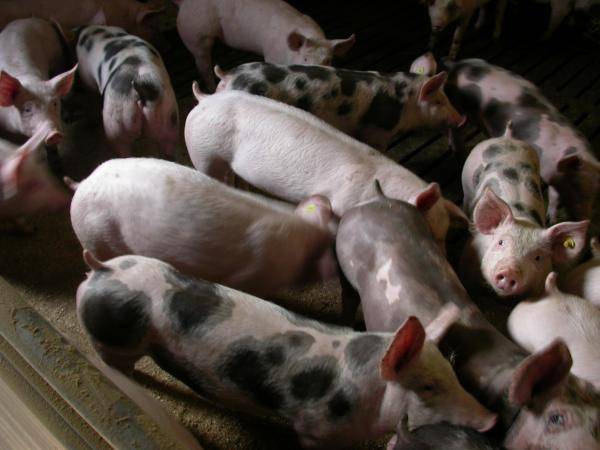VevoVitall (99.9% benzoic acid, 4d210) is one of the most widely used zootechnical additives in pig feed. The acid is registered in the EU for use in feed for piglets, fattening pigs and sows. There is no legal minimum for VevoVitall in piglet feed, but there is one for using it in feed for sows and fattening pigs, and it has been set at 0.5% in the past. For some time now, DSM has been working to decrease the legal minimum in fattening pig feed from 0.5 to 0.3%. After a positive EFSA advice, EU legislation was recently amended. The EU legal minimum in sow feed does not change and therefore remains 0.5%.
The application of VevoVitall (4d210) in fattening pig feed is now regulated according to the new EU Regulation (EU 2020/1031 - annex): minimum 0.3% - maximum 1.0%.
Adding 1.0% VevoVitall in fattening pig feed?
The 1% dose remains recommended for maximum reduction of ammonia emissions. This level of application was recognized in the 'Stoppersregeling' (The Dutch Cessation Scheme[LL1] ) as well as within the Flemish and Dutch PAS (Integrated Approach to Nitrogen) regulations.
Those looking for a maximum effect on the reduction of urine pH and ammonia emissions should also opt for the 1% dose.
Adding 0.5% VevoVitall in fattening pig feed?
The 0.5% dose is mainly used for improved zootechnical results and stable intestinal health in fattening pigs. Based on 19 - mainly European - pig trials involving more than 10,000 fattening pigs, addition of 0.5% VevoVitall appears to increase daily growth by an average of 4.5%, while feed conversion decreases by 4.5% on average. Few other zootechnical feed additives can produce such recorded results. Most test show that increasing the dosage above that level shows no additional improvement in the technical results.
If you are aiming for maximum improvement of zootechnical results, it is best to opt for 0.5% dosage. And therefore, this remains the recommended dosage for use in piglet [JS2] [LL3] and fattening pig feeds.
This inclusion is also still recommended for preventing formation of yeasts in liquid feed.
Adding 0.3% VevoVitall in fattening pig feed?
Although the effects of 0.5% VevoVitall in fattening pig feed are particularly positive, the main drawback of using it lies in the substantial increase in the gross feed cost (€/T). But not every pig farmer seems willing to invest heavily in higher feed costs early on in a production cycle, only to reap the benefits three months later. And that is certainly so in periods when pig prices are low and feed costs are high.
In view of that, in August 2017, DSM initiated a procedure to lower the legal minimum VevoVitall dosage in fattening pig feed from 0.5 to 0.3%. This effectively reduces the cost of including the additive by 40%, making application in that part of production much more cost-bearable.
Of course, the obvious question arises as to what this means in terms of the effect on the zootechnical results. Three new fattening pig trials (included in the EFSA report below) show that 0.3% VevoVitall continues to increase daily growth by between 3.1 and 4.4%. This means that roughly 75-80% of the improved result is retained when using the lower dosage. A logical and obvious consequence of this is that the return on investment (ROI) of using the additive also increases when applying the 0.3% dosage.
Adding 0.5 & 0.3% VevoVitall in fattening pig feed?
Those looking for the highest economic return are advised to start with the 0.5% dosage in the starter [LL4] feed (25-45 kg) and then switch to the 0.3% dosage in the finishing feed (45 - 115 kg). Several tests have shown that this achieves the best return on investment (ROI).
This feed additive schedule is also recommended in concepts aimed at protecting gut health. Especially now that the pig farmer is facing important challenges (more and more pressure on the use of antibiotics, phasing out the use of ZnO in piglet feed, etc.), application of 0.3% VevoVitall can also be considered when developing specific health concepts for heavier fattening pigs. But those who want to build in maximum protection should stick to the 0.5% dose (or even higher...).
Practical consequences in pig feed?
- Fattening pig feed with reduced benzoic acid content:
- This regulatin enters into force on 4 August 2020 and is binding in every EU member state
- Mdification of benzoic acid content to be reported on the feed label
- Items that remain unchanged:
- Legal maximum in piglet feed (0.5%)
- Legal minimum (0.5%) and maximum (1.0%) in sw feed
- EU registratin number 4d210 (on label!)
- Items listed n the label: 'Animal feed additives containing benzoic acid should not, as such, be fed to fattening pigs.' 'Animal feed additives containing benzoic acid must be well mixed with the other feed materials in the daily ration.'
If you would like more information about this adapted EU legislation: please get in touch with your contact person at Twilmij!
Animal nutritionists ir. L. Levrouw - ing. M. Snoeck


